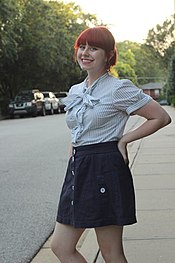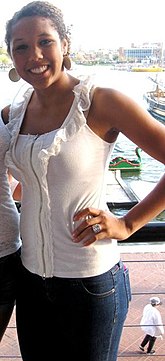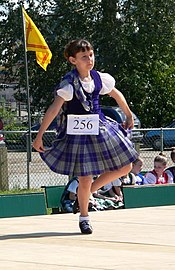Women's Fashion Elegant Strip Blouses Turn Down Collar Shirt Tops Blouse

A modern striped bow tie neck blouse and a navy blue mini skirt.

A blouse ()[1] is a loose-fitting upper garment that was worn past workmen, peasants, artists, women, and children.[2] [iii] Information technology is typically gathered at the waist or hips (past tight hem, pleats, parter, or belt) then that it hangs loosely ("blouses"[4]) over the wearer's body.[3] Today, the word most usually refers to a daughter's or woman's dress shirt.[v] It can also refer to a human's shirt if it is a loose-fitting style (due east.g. poet shirts and Cossack shirts),[2] [6] though it rarely is. Traditionally, the term has been used to refer to a shirt which blouses out or has an unmistakably feminine appearance.
The term is too used for some men's military uniform jackets.[7]
Etymology [edit]
Blouse is a loanword from French to English (come across Wiktionary entry blouse). Originally referring to the blue blouse worn by French workmen,[2] the term "blouse" began to be practical to the various smocks and tunics worn by English farm labourers. In 1870, blouse was showtime referenced as beingness "for a young lady."[eight]
Information technology is suggested that the French form of the give-and-take comes from the Latin pelusia, from the Egyptian town of Pelusium, a manufacturing heart in the Centre Ages, or alternatively from Provençal (lano) blouso 'short (wool)'.[9]
Description [edit]


Blouses usually consist of low-cal fabrics such every bit silk or thin cotton fabrics, until the early 1990s are often made of softly falling constructed fibers (e.g. polyester). Sometimes they are decorated with frills, embroidery or loops. The archetype of the ladies' blouses is the white shirt blouse (post-obit the classic elegant white men's shirt). Hither the combination possibilities are specially diverse. The open spade, peter pan, reverse and revere collar is another mutual type of classic ladies' blouse.
Blouses are oft made of cotton or silk cloth and may or may not include a collar and sleeves. They are mostly more tailored than simple knit tops, and may contain feminine details such as ruffles, a necktie or a soft bow at the neck, or embroidered decorations.
Tailoring provides a closer fit to the wearer'south shape. This is achieved with sewing of features such as princess seams or darting in the waist and/or bust.
Blouses (and many women's shirts with buttons) usually take buttons reversed from that of men's shirts (except in the instance of male armed services fatigues). That is, the buttons are ordinarily on the wearer'south left-hand and the buttonholes are on the right. The reasons for this are unclear, and several theories exist without have conclusive testify. Some suggest this custom was introduced by launderers and so they could distinguish between women's and men's shirts. Ane theory purports that the tradition arose in the Centre Ages when one way of manifesting wealth was by the number of buttons one wore. Another that the original design was based on armour which was designed so that a right-handed opponent would not take hold of their weapon in the seam and tear through, and that a person could draw a weapon with their correct-hand without communicable it in a loose seam of their own clothes.
Female servants were in charge of buttoning their mistress'southward gowns (since the buttons were normally in the back). They tired of attempting to deal with buttons that were, from their betoken of view, backwards and, as such they started reversing the placement when making or repairing them. Another possible reason is so that men can easily undo blouses as, from the front, buttons are on the same side as a man's shirt. 1 other theory is that women were commonly dressed by their maids, while men dressed themselves. As such, women's blouses were designed so it could be easily buttoned by the maid simply that of men were designed and then it could be easily buttoned past the person wearing it.
Although in all the cases proposed the reasons for the distinction no longer exist, it continues out of custom or tradition.
While most women prefer to have the tiptop button open for meliorate comfort, some blouses made for women have looser necklines then the top push can be fastened without compromising comfort, but giving the same stylish appearance.
Some women attach diverse pins and ornaments to their blouses over a attached tiptop push for way. Some of these attach directly to the button itself, others to the collars.
History [edit]

Giuseppe Garibaldi (center), the Italian patriot and his wife, Anita (right), popularized the red, Garibaldi shirt, a type of war machine blouse, which became popular, as early 1860s, civilian fashion, with men and women, both, in Europe and the North America.

Blouses from 1890-1900 Australia.
Pre-WW1 [edit]
Blouses are historically a cask style, mostly mail-similar garment[ vague ], that were rarely part of the fashionable woman'south wardrobe until the 1890s. Before that time, they were occasionally popular for breezy wear in styles that echoed peasant or traditional clothing, such equally the Garibaldi shirt of the 1860s.[2]
Some blouses do not have a height button at all, and collars are intentionally styled to exist open up. They also form office of some nations' traditional folk costume.
During the later Victorian period blouses became common for breezy, practical clothing. A simple blouse with a plain skirt was the standard dress for the newly expanded female (non-domestic) workforce of the 1890s, especially for those employed in part work. In the 1900s and 1910s, elaborate blouses, such as the "lingerie blouse" (so-chosen because they were heavily decorated with lace and embroidery in a style formerly restricted to underwear) and the "Gibson Girl blouse" with tucks and pleating, became immensely popular for day-wear and even some breezy evening wear. Since then, blouses take remained a wardrobe staple, and then by at present blouses have not ceased to exist fixed in the "pop cloakroom" style.
German magazine "Dice Woche" wrote in 1913 about ladies' blouses in connectedness with riding:
- "Fifty-fifty if more than and more than justification is given for the hot summer days of the casual blouse, the archetype riding dress made of velvet or English linen still remains unmatched."
At the end of the 19th century the sailor blouses derived from sailor suits were popular for girls to the bluish pleated skirt. In the time of National Socialism this piece of clothing was rejected equally a bourgeois-decadent. In the 1950s, the sailor's expect then entered the leisure style for adults.
The loftier collar in blouses was pushed out during this time by the halsferne variant. Specialist shops besides offered "ladies' cloaks". KdW in Berlin practical in his illustrated main catalog: 1913 amid other things a backfisch-confection, with eight blouses between 2.75 and ix.50 Marks. The simplest model was a "launder blouse, navy, white spotted", the most expensive one "blouse, white, launder, with tip and stick". One of the novelties of the flavour was the pointed "Charmeuse blouse, very elegant form, pure silk, with very fluffy crepe and lace gown".
The inter-war years [edit]
Various new and different forms of collar emerged in the 1920s. They diminished in sizes by the 1950s,[2] but were often large in the 1930s.[2]
The silk 'jumper blouse'[two] and the low-cut 'Five-neck shirt' (or Chelsea collared blouse)[2] were the fashion hit of the 1920s.[2] They had full length, short, 3⁄4 length and bell shaped sleeves.[two]
Styles since World State of war Two [edit]

A Japanese blouse (left), in 1951.
The size of collars had macerated by the 1950s,[2] but were huge in the 1930[2]s. At the beginning of the 1970s, pop styles included the rounded collar,[two] sausage domestic dog neckband,[two] then extra wide collar and double cuffs from shirts, that fell on them oft from fashions relating to constructed fabrics like usually polyester. At the beginning of the 1960s bubic bangs came back, then later wide collars. The fashion of continuing collar and federal neckband, loops, rounded collars, revere neckband and the smallest collar, sometimes with concealed push button fly on a "smoking blouse", attached folds and stressed set-in-followed in the 1980s. Again, thin and oft shining constructed fibres were very popular.[2] Towards the end of the 20th century, they were of an extra-long blouses of pants style and worn over trousers or skirt worn, optionally combined with a rather wide chugalug effectually the waist in Germany, the Netherlands, Kingdom of belgium, Denmark, Poland, the Great britain, Republic of ireland, South Africa and the US.
The sleeves had been shortened during the early on 1950s to the 1⁄ii and 1⁄4 length in Europe. They were reduced over again in the mid-1990s and are now regularly at the 7⁄8 , 1⁄2 , 1⁄3 and 1⁄four length around the world. Equally the heart will be drawn to the naked flesh below the sleeve, designers often use sleeve length to focus the minds centre on the slimmer parts of the arm, peculiarly short sleeve blouses below the elbow to give the illusion of a slimmer arm. Sleeveless tops were stylish and a topical item in Western Europe and North America during the mid-2000s.[ citation needed ]
Many fashionable styles of both the 1970s and 1980s were on the go again after the millennium in the blouse style: double cuffs, extra wide pointed neckband, belt effectually the waist, constructed fibre and the like. Frequently the blouses also embroidery or "crystal stocking", have especially on collar and string. The blouses with the so-chosen iii-quarter arm were a striking phenomenon of the 1990s. Blouses can exist combined well and hands with a blazer, tank peak, bolero or sweater, with or without some colourful silks or bead concatenation necklaces.
Eco movement [edit]
As part of the Eco movement's folk blouses for women were cut from natural materials such as flax, linen and cotton. Men also wore these "Frisian blouses" on occasion.
Cultural blouse styles [edit]
Use with a dirndl [edit]

A woman wearing a dirndl. The white function on her torso and artillery is the blouse.
A woman wearing a dirndl, with white blouse, is usual in Bavaria and rural Austria. They are normally made of light fabric (fabric), such as silk or cotton thin, until the early on 1990s however oftentimes from soft covered by art faserstoffen (such every bit polyester and satin). They oft accept fanciful decorations (such equally frills, embroidery, or grinding) and are a classic among the women'due south blouses—here the fashionable combination possibilities are especially varied. The open up Spaten—or lapel collar—is another common type of a classic ladies´ blouse.[10]
The blouse is worn under the bodice of the dirndl. Information technology is cropped just above the waist. The blouse changes the overall effect of the dirndl especially through the cut of its neckline. A deeply cut blouse combines with a securely cut bodice to accentuate décolletage, whereas a blouse with a loftier neckline creates a more small effect. In traditional designs, the blouse neckline is at the base of the throat. Other popular necklines are V-shaped, balconette or heart-shaped. Materials about frequently used are cambric, linen or lace; the color is commonly white. Curt puff sleeves are typical, although narrow sleeves (short or long) are also common.[10] [11] [12] [thirteen]
Use in Aboyne dress [edit]

A young Highland dancer wearing the Aboyne dress prescribed for female person dancers for the National dances.
In one version, a tartan pattern skirt is worn with an over-the-shoulder plaid, a white blouse and petticoat, and a velvet bodice. The alternative is a white dress over a petticoat, together with a tartan pattern sash. A typical Aboyne apparel consists of a dark bodice or elaborate waistcoat, decorative blouse, full tartan skirt and some times a petticoat and apron. Some have a tartan sash (usually draped over the shoulder and coming downward towards the hem of the skirt in the back) rather than an apron.[14] [15] [16] [17]
The blouse jacket or blouson [edit]
The blouse jacket or blouson is garment drawn tight at the waist with blousing hanging over the waist band. The new style of homo's chetten lose blouse coat is made of stronger fabric or with inner lining, which tin can be worn alone or as a step on for a top. It is related to the Eisenhower jacket.
Come across also [edit]
- Choli
- Wearing apparel
- Skirt
References [edit]
- ^ "blouse" – via The Complimentary Lexicon.
- ^ a b c d e f g h i j k l thou north o "The History of Blouse". Patra Selections Weblog: Silk Vesture and Underwear. 30 March 2015.
- ^ a b The Concise Oxford English Lexicon
- ^ "blouse – definition of blouse past the Free Online Dictionary, Thesaurus and Encyclopedia". Thefreedictionary.com. Retrieved fourteen Baronial 2012.
- ^ "Glossary B # three". Apparelsearch.com. Retrieved 14 August 2012.
- ^ Gavenas, Mary Lisa (2008). The Fairchild Encyclopedia of Menswear. p. 47. ISBN978-1-56367-465-5.
- ^ "Marine Lexicon". Toysforkidsvt.com. Retrieved xiv August 2012.
- ^ Cresswell, Julia (2002). Oxford Dictionary of Word Origins (two ed.). Oxford: Oxford University Press. p. 51. ISBN978-0-xix-954793-7 . Retrieved 17 May 2020.
- ^ "blouse - Origin and meaning of blouse by Online Etymology Dictionary". world wide web.etymonline.com.
- ^ a b "Ein Kleid für die Dirn' – Mode & Kosmetik – derStandard.at › Lifestyle". Derstandard.at. five September 2006.
- ^ "The essential Dirndl (and Lederhosen) guide". www.republic of austria.info . Retrieved 9 June 2020.
- ^ Daniela Müller and Susanne Trettenbrein. Alles Dirndl. Anton Pustet Verlag, Salzburg 2013. ISBN 978-3-7025-0693-3
- ^ "Dirndlbluse, die". Duden . Retrieved 30 July 2020.
- ^ "Aboyne". Highland Reel. Highland Reel, Aberdeenshire, Scotland. Retrieved 29 July 2018.
- ^ DONALDSON, Emily Ann (1986). The Scottish Highland Games in America. Pelican Publishing. p. 142. ISBN978-1565545601.
- ^ "Aboyne Highland Games". Aboyne Highland Games. Aboyne Highland Games Committee. Retrieved 29 July 2018.
- ^ "Bridal Blouse For Wedding". ii Dec 2021.
0 Response to "Women's Fashion Elegant Strip Blouses Turn Down Collar Shirt Tops Blouse"
Post a Comment